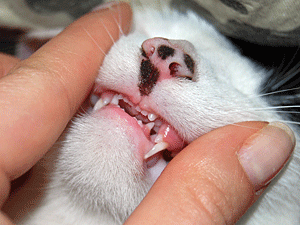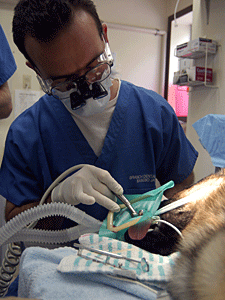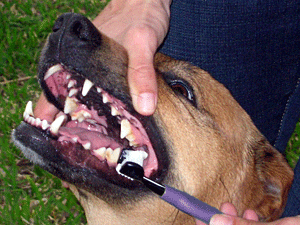 On August 16, 2011, Patricia M. Dominguez, BS, LVT, VTS (Dentistry), a practicing Veterinary Dental Technician Specialist at Gotham Veterinary Center on the Upper West Side of Manhattan, presented a Dog and Cat Dental Awareness session for Mayor’s Alliance Participating Organizations and others as part the Alliance’s ongoing Strength Training Program. The ASPCA hosted the session at its Midtown offices. Patricia prepared the following article to summarize the material from the session.
On August 16, 2011, Patricia M. Dominguez, BS, LVT, VTS (Dentistry), a practicing Veterinary Dental Technician Specialist at Gotham Veterinary Center on the Upper West Side of Manhattan, presented a Dog and Cat Dental Awareness session for Mayor’s Alliance Participating Organizations and others as part the Alliance’s ongoing Strength Training Program. The ASPCA hosted the session at its Midtown offices. Patricia prepared the following article to summarize the material from the session.
Why should we worry about our pets’ teeth?
A healthy mouth is a healthy body! It’s as true for our pets as it is for us. In human medicine, periodontal disease has been proven to be linked to many disease processes. Based on studies done by the American Veterinary Dental Society, 85 percent of adult pets have some stage of dental disease. The bacteria found in the plaque and tartar can also cause harmful effects to our pet’s heart, lungs, kidneys, and liver. If left untreated, this infection causing bacteria will lead to issues in the mouth like: gingivitis, bleeding gums, excessive drooling, tooth decay, root infections, bone loss, abscesses, tooth mobility, and even tooth loss.
Almost all dogs and cats will continue to eat no matter what ailments they may be experiencing. This is true for one simple reason — the instinct of survival. To better relate, let us put ourselves in their situation. Imagine if you were stuck on a deserted island with a broken or abscessed tooth. Would you stop eating? Certainly not! You would continue to eat, drink, breathe, and live day to day. You would not be the healthiest or most comfortable person in the world but you would learn how to live with it — and that is what our pets do! They learn how to live with it because they do not have a choice. They live in a world in which they cannot express themselves through words, but rather actions. So although they may not be able to tell us that one of their right lower molars is moving, they may instead choose to eat their food on the left side of their mouth. Still others may opt to swallow their food whole, shy away from dry food altogether, or simply prefer not to chew on their toys. It is up to us as responsible pet parents to provide adequate medical attention, which includes proper dental care.
As with everything in life, preventative maintenance is much easier (and less expensive) than medical treatment. By doing regular home care and routine professional dental cleanings, we can help prevent periodontal disease or diagnose it before it advances. This will save many of our pets from the pain and systemic harm dental disease can cause.
Why don’t dogs and cats in the wild need dental care?
A great number of our domesticated dogs today do not have the same skull structure of their wild wolf ancestors. This can create problems when trying to fit 42 teeth into the skull structure of a Chihuahua or a Toy Poodle. Many small dogs are prone to periodontal disease at an early age due to rotated teeth, crowded teeth, or retained baby teeth. These conditions create areas where it is easy for food, hair, and debris to get caught and attract bacterial infection. This can be compared to a human’s need to floss daily. Our teeth may not have tartar accumulation and yet it is the bacteria in between the teeth and below the gum line that causes the real damage. That is why professional evaluations and cleanings are so important.
Our domesticated cats and dogs are not capturing their own prey and eating the same diets as their wild counterparts. Thus, they are not getting the positive benefits that chewing through hide, muscles, tendons, and bone can provide. Cats and dogs in the wild suffer from many medical issues that are only treated when humans intervene. If they encounter dental issues, then their ability to hunt is decreased and they are at a disadvantage. We have seen this situation occur in our zoos when a lion or a tiger breaks a canine tooth and only finds relief after a root canal procedure is done.
 What does a professional dental involve and why is anesthesia necessary?
What does a professional dental involve and why is anesthesia necessary?
Almost everything that is done in human dentistry can be done in veterinary dentistry. That being said, we are strong advocates of home care and maintenance professional cleanings for prevention. In order for your pet to have a professional cleaning, they must first have a recent exam and pre-anesthetic blood work to make sure they are good candidates for general anesthesia. General anesthesia is necessary to do a complete and safe job of removing the bacteria from all surfaces of the teeth. It is important to remove the bacteria from the subgingival spaces where periodontal disease begins. This is essential in providing the highest quality dental procedure. Proper anesthetic protocol gives us the ability to clean, examine, and treat any affected teeth. Oxygen and a gas inhalant are delivered through a cuffed endotracheal tube to keep an open and protected airway. This allows us to scale and polish all surfaces of the teeth, both above and below the gum line.
We are then able to perform a complete oral exam to uncover any abnormalities. This involves examining each individual tooth — cats have 30 teeth, dogs have 42. Every finding is charted into their permanent dental record. If abnormalities are found, digital dental radiographs are needed to properly evaluate the health of the tooth and root structures. Some conditions commonly found in the oral cavity are (but not limited to): loose teeth, missing teeth, retained baby teeth, fractured teeth, discolored teeth, worn teeth, rotated teeth, crowded teeth, gingival recession, exposed roots, abscessed roots, periodontal pockets, and oral masses.
A complete dental prophylaxis at Gotham Veterinary Center includes:
- Physical Exam: Allows us to properly assess the patient’s general health by evaluating their weight, temperature, heart, lungs, eyes, ears, nose, throat, skin, abdomen, and extremities.
- Pre-Anesthetic Blood Work: This is a blood test that detects major organ and metabolic abnormalities that may complicate the anesthetic procedure.
- Anesthesia & Monitoring: Inhalant gas anesthesia provides a safe and comfortable cleaning. This includes monitoring of the heart, respiration, blood pressure, blood oxygen levels, and temperature. An intravenous catheter is placed to allow fluid therapy before, during, and after the procedure. This helps with circulation and vascular perfusion.
- Full Oral Exam & Charting: A record of the oral cavity and each individual tooth, during which all abnormalities are noted.
- Dental Scaling: The process that removes the calculus and plaque both above and below the gum line.
- Dental Polishing: Necessary for finishing the scaling and cleaning process. Provides a smooth tooth surface after scaling and delays the reattachment of plaque-causing bacteria.
- Dental Radiographs: Dental radiographs (x-rays) are taken to access subgingival pathology and overall health of the teeth.
- Treatment Plan/Extractions: A treatment plan is formulated to treat any affected teeth that can be saved. Any tooth causing severe infection should be extracted.
- Irrigation & Fluoride Treatment: We use an antimicrobial wash to rinse away bacteria followed by a fluoride treatment to strengthen tooth enamel.
- Antibiotics: If there is significant periodontal disease, antibiotics will be administered.
- Pain Management: Based on the needs of your pet and the procedure done. We strive to ensure the utmost comfort of your pet.
- Client Education: The dental specialist will meet with you after the procedure to discuss everything that was done and develop a home care regimen for you and your pet.
 What is a proper at-home pet oral care regimen?
What is a proper at-home pet oral care regimen?
Many veterinary dental approved products are available to help reduce plaque and tartar accumulation. The best way to keep your pet’s teeth clean is by brushing daily with a pet toothpaste and toothbrush. Pet toothpastes come in flavors that your pet may find enjoyable, such as chicken, beef, peanut butter, malt, seafood, and vanilla. If your pet enjoys the flavor of the toothpaste, then they will probably enjoy the brushing experience. Just like us and mint flavored toothpaste!
How to brush your pet’s teeth:
- The first thing you should do is find a flavor of toothpaste your pet will like. Put some on your finger, a treat, or on a toy and offer it to your pet. This way your pet will get used to the flavor of the toothpaste and realize it can be a yummy reward.
- Next, put a little bit of the toothpaste on the toothbrush and let your pet lick it off. This will help them get used to the feeling of the bristles on their tongue, gums, and teeth. They will slowly realize that even though the brush may feel different, it is nothing they have to be scared of.
- Once your pet is comfortable licking the toothpaste off of the toothbrush without hesitation, try brushing the front teeth in a circular motion.
- If your pet is comfortable having your fingers and toothbrush around their mouth, try brushing the teeth further to the back in a circular motion. Try to spend at least 30 seconds on each side.
- Don’t worry about the inside of the teeth — most pets won’t let you brush the inside.
Important tips:
- Use pet toothpaste, not human toothpaste, as this can be harmful to your pet when swallowed.
- Use lots of positive reinforcement to make it an enjoyable experience for you and your pet.
- Put the toothpaste and toothbrush somewhere where you will see it every day — next to their food, next to the leash, or on the coffee table. That way it will become part of your daily routine.
- Go slowly — every pet is different and will go through the steps at their own pace. Some will take a few days to get used to this new experience; some will take a few weeks. Stay committed, dedicated, and patient.
If brushing your pet’s teeth is not possible, or you want to incorporate different products into your home care regimen, then talk to your veterinary care professional about oral gels, barrier sealants, rinses, water additives, dental diets, and dental chews. Make sure to discuss any new products with them before trying them on your pet. The Veterinary Oral Heath Council (VOHC) approves products that have been proven to fight plaque and tartar buildup. Look for the VOHC’s seal of approval as a guide for products that have met their standards.
Resources on Veterinary Dentistry
American Veterinary Dental College
Academy of Veterinary Dental Technicians
American Veterinary Dental Society
Hills Pet Nutrition
Veterinary Oral Health Council
 About the Author
About the Author
Patricia M. Dominguez, BS, LVT, VTS (Dentistry) is a practicing Veterinary Dental Technician Specialist at Gotham Veterinary Center on the Upper West Side of Manhattan in New York City. She was among the first, and remains one of the few, to become a credentialed Veterinary Dental Specialist through the Academy of Veterinary Dental Technicians. Patricia has cultivated a superb reputation and strong client relationships by establishing a patient care philosophy that stems from her unconditional love of all animals. She has been featured in several publications educating others on the need for providing high quality dental services. Patricia has also lectured around the country on topics ranging from veterinary dental awareness for the general public to improving standards of dental programs at each animal hospital.
Gotham Veterinary Center
700 Columbus Avenue
New, York, NY 10025
(212) 222-1900
www.gothamvetcenter.com
pdominguez@gothamvetcenter.com

